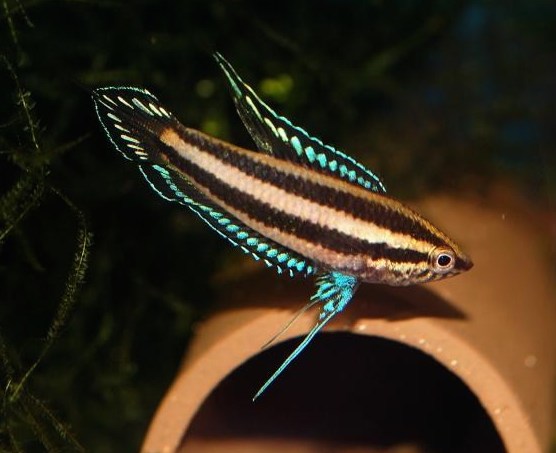
Kottelat & Ng 1998
First description: Valid today: Parosphromenus bintan, a new osphronemid fish from Bintan and Bangka islands, Indonesia, with redescription of P. deissneri. Ichthyological Exploration of Freshwaters, 8: 263-272. – Until the publication of this new description, the first description was valid: P. Bleeker, Negende bijdrage tot de kennis der vischfaunavan Banka. Natuurkundig Tijdschrift voor Nederlandsch Indie, 18:359-378.
The redescription with the approval of the nomenclature authority, ICZN, a century after its first description, is very unusual, but nevertheless follows the regulations. The ICZN confirmed this in the following publication: ICZN, 2000.Opinion 1946th Osphronemus deissneri Bleeker, 1859 (currently Parosphromenus deissneri; Osteichtyes, Perciformes): holotype replaced by a neotype. Bulletin of Zoological Nomenclature, 57 (1): 60
Background: in the nineteen nineties it was already clear that the original view, there was only one Parosphromenus species, had been wrong. It was also obvious that the licorice gouramis, found up to that date and usually labelled as “P. deissneri”, must have belonged to different species. Therefore there was an interest to examine Bleeker’s original fish (one specimen) again in the light of this new findings. When Kottelat and Ng did so, quickly three things became clear. First, the specimen was in very poor condition. Second it was a female and thus lacked important species differentiation characteristics; such as colours, which barely remain in the conserved state. Third, by this time it was already known that at least two different Parosphromenus species exist on Bangka, which can be distinguished structurally by the shape of their tail fin. The caudal fin would have been an important structural differentiation characteristic, but the specimen lacked this. Meanwhile, because the old holotype could no longer be used to decide which of the two Bangka species really is deissneri, the two ichthyologists requested to assign a neotype and to describe the species on this basis. This proposal was accepted. In this case it was decided that not the species with the round tail fin, but the other with a clear filament in its tail fin would be (deissneri). (Remark PF: If the decision had been taken to select the other species, much of the confusion about the species´ name could have been avoided. But it is now idle to speculate about it). The other, round finned species was then described as P. bintan, because it occurs on the island Bintan as well.
Characteristics: Overall length max. 5 cm, making it one of the largest licorice gouramis. Dorsal structure: XII-XIII, 6, total 18-19, Anal: XII-XIII, 8-10, total 21-23. ♂ in nuptial plumage structurally well identifiable by the triangular, up to one centimeter long black caudal filament. Additionally it is very characteristic that the light patterns in the unpaired fins are not continuous, but single short light bands. Especially in the caudal fin this characteristic is very obvious, as the lines located there have a horizontal and nearly parallel offset. P. deissneri males are therefore among the most easily recognizable licorice gouramis (see illustration).
Similar species: the risk of confusion with other licorice gouramis is low for the males, due to the phenotypic differentiation, which is based on structural (caudal fin with distinct black filament) differences and on the characteristic colour patterns. For the females the risk is higher; here the (less obvious) differences in physique have to be considered. However it has to be pointed out again that the permanence of using the historic name until 1998 for various kinds of licorice gouramis, still confuses large parts of the aquarium hobby, although, at least for the males, a differentiation is almost no problem. Not only in the trade, but also in many internet publications and in un-specialised general aquarium articles and books,this wrong designation still occurs almost unabated.
Occurence/Distribution: following the first description, deissneri is endemic on the Malayan island Bangka, but has been found later on the neighbour island Belitung as well. Obviously it has not spread further .
Threat: Due to the restriction of occurrence on these two islands the threat is very high.
Discovery/First import:
Trade: as already mentioned, it is still almost impossible to disentangle the name and identification confusion in the international trade. Only gradually have the exporters and importers realised that there was this new description, which forbids the identification of most of the licorice gouramis, offered in trade, as deissneri. Unaffected by this, many of the licorice gouramis are still incorrectly traded as deissneri. However, until a few years ago, real P.deissneri have obviously never been traded. Only recently have there been few imports to Europe or America, but due to the name confusion these fish have soon disappeared and were lost in the totality of traded licorice gouramis, before specialists could get hold of them. The aquarium strains, swimming today in a few tanks, go back to private imports (e.g. Kopic, Brown, ).
Care / Breeding: No special conditions that deviate from the usual Paros water standards are required. However, note that deissneri is one of the largest and strongest licorice gouramis. Therefore, they should not be kept in the smallest tank. In the long run, a 12-liter tank would be too small and a 25-liter tank would be the minimum. The nests can be large (over 100 eggs, but usually less).
Behaviour/Particularities: no particularities. Horizontal to head down courtship. Often with very distinct foam nest, sometimes only rudimentary nest. Large deissneri belong to the most impressive forms we know.
Literatur:
Weblinks:

